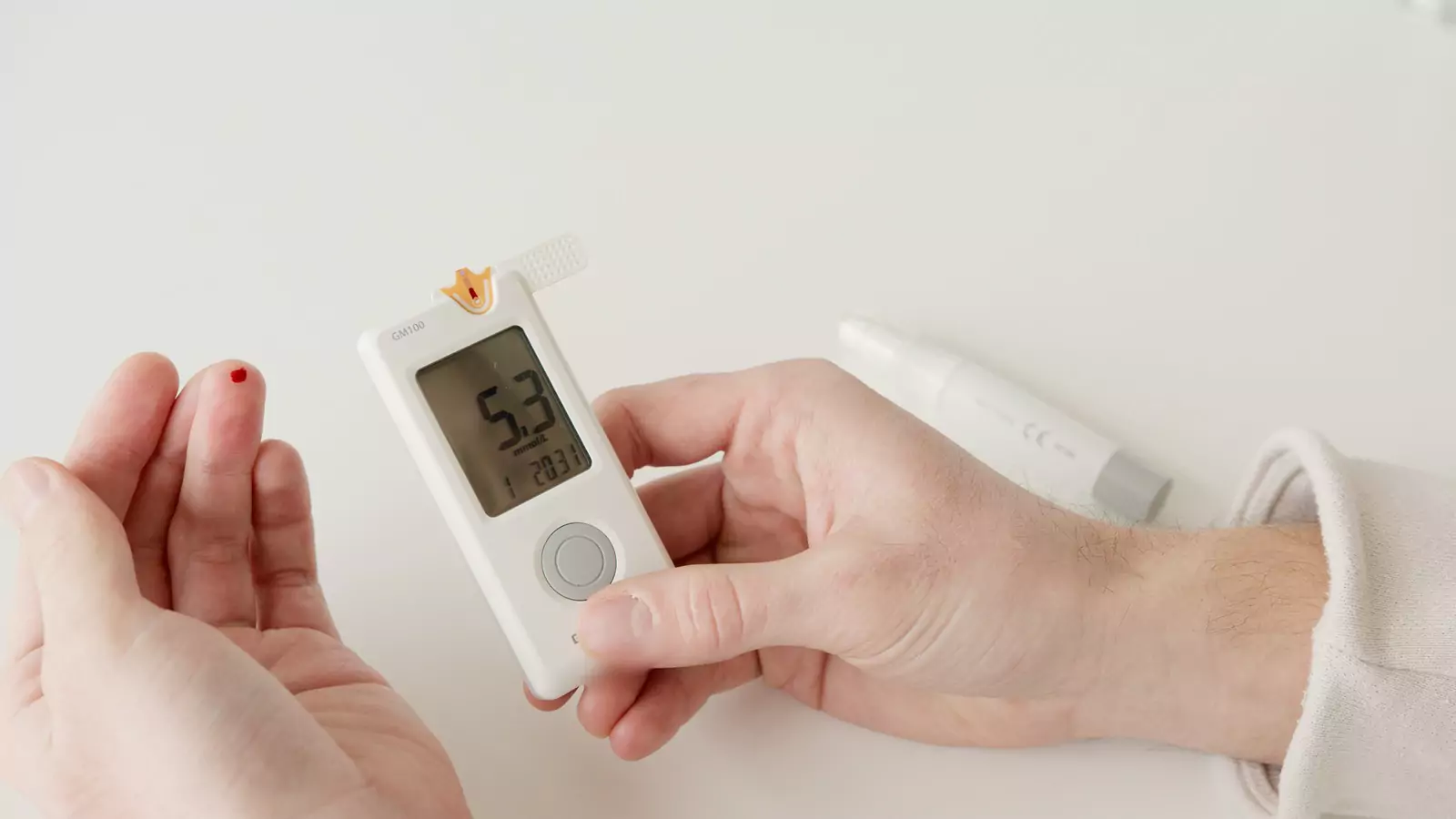





Pump it Up: The Power of Exercise in Diabetes


Table of Contents
- The Link between Diabetes and Quality of Life
- SugarMD Advance Glucose Support
- Benefits of Exercise for Diabetes
- Improves Blood Glucose Control
- Reduce Blood Pressure
- Helps Manage Weight
- SugarMD Weight Loss Formula
- Reduce Risk of Complications
- SugarMD DiaVitamin and Neuropathy Support
- The Basics of Exercise
- Types of Exercise
- Frequency and Intensity of Exercise
- Safety Concerns
- How to Get Started
- SugarMD Super Berberine
- Set Reasonable Goals
- Find an Exercise Buddy
- Go Slowly and Have Fun
- Conclusion
- About The Author
Exercise is one of the most important strategies for managing diabetes but it's often overlooked or underestimated. The truth is that physical activity plays a vital role in helping people with diabetes stay healthy and prevents potentially serious complications. In this article, we’ll look at the benefits of exercise for people with diabetes and how to get started. We’ll also discuss the basics of exercise, types, frequency and intensity, safety concerns and how to set reasonable goals and find an exercise buddy.
The Link between Diabetes and Quality of Life
Quality of life is an essential aspect of overall well-being. It refers to an individual's ability to enjoy daily activities socialize and maintain good mental and physical health. Unfortunately, people with diabetes often experience a lower quality of life due to the condition's negative impact on their health and daily routines. Type 2 diabetes, in particular, is associated with several complications that can reduce a person's quality of life.
These complications can affect major organs of the body in long-term. High blood glucose levels can damage nerves, blood vessels and organs, leading to issues such as blindness, kidney failure and heart disease. It does not end here; people with diabetes also have a higher risk of developing other health conditions such as high blood pressure and obesity which can further diminish their quality of life.
Research has shown that physical activity can improve the quality of life for people with diabetes. Regular exercise can help manage blood glucose levels, reduce body weight and improve insulin sensitivity, all of which can lower the risk of complications associated with diabetes. According to the American Diabetes Association, people with diabetes should aim for at least 150 minutes of moderate-to-vigorous physical activity per week, spread across at least three days.
Aerobic exercise such as walking, cycling or swimming, is an effective type of exercise for people with diabetes. Aerobic exercise can help lower blood sugar levels by increasing insulin sensitivity which allows the body to use insulin more effectively. It also improves cardiovascular health which can reduce the risk of heart disease and other complications.
Resistance training, also known as strength training, is another beneficial type of exercise for people with diabetes. Resistance training can help build muscle mass which can improve insulin sensitivity and lower blood sugar levels. It can also help maintain bone density and reduce the risk of falls which is especially important for older adults with diabetes.
Aside from these health benefits, physical activity can also have a positive impact on mental health, reducing stress and anxiety and improving overall well-being. Moreover, regular exercise can help people with diabetes achieve and maintain a healthy body weight which can improve their quality of life and reduce the risk of complications.
In conclusion, people with diabetes can benefit greatly from regular physical activity. Aerobic exercise, resistance training and other types of exercise can improve insulin sensitivity, lower blood sugar levels and reduce the risk of complications such as heart disease. The American Diabetes Association recommends at least 150 minutes of moderate-to-vigorous physical activity per week, spread across at least three days, to achieve these health benefits. Exercise is an effective tool that people with diabetes can use to improve their quality of life and achieve better health outcomes.
SugarMD Advance Glucose Support
Maintaining healthy blood sugar levels can be a challenge. From carby meals to snacks and even with all the effort, it’s still not enough. That’s where SugarMD Advanced Glucose Support comes in. Our blend of traditional Ayurvedic herbs helps regulate blood sugar levels, curbs cravings, supports weight loss, boosts metabolism and energy. Endorsed by endocrinologists, this unique formula of pure, potent herbs promotes overall blood sugar health. Ideal for both pre-diabetics and Type 2 diabetics.
Benefits of Exercise for Diabetes
When it comes to managing diabetes, exercise is one of the most powerful tools that both individuals and healthcare professionals can use. Exercise in diabetes plays an important role in both controlling the disease itself and maintaining a healthy lifestyle.
Some of these benefits are:
Improves Blood Glucose Control
Exercise has long been touted as a key component of diabetes management and has been found to be one of the best ways to improve blood glucose control. Studies have shown that regular exercise can reduce fasting blood glucose levels and improve A1C levels which is an important measure of blood glucose control.
Regular exercise also helps to reduce other risk factors associated with diabetes such as high blood pressure, high cholesterol and obesity. The exact mechanism by which exercise helps improve blood glucose control is not entirely clear. However, it is thought that exercise affects the body's cells in a number of ways.
It increases the body's sensitivity to insulin which allows cells to absorb more glucose from the blood. Additionally, it may help to reduce the amount of glucose produced by the liver which helps to balance out glucose levels.
Reduce Blood Pressure
Blood pressure is an important indicator of overall health and it is directly related to physical activity. According to the American Diabetes Association, physical activity has the potential to reduce blood pressure significantly in those with diabetes. Regular physical activity helps the body use insulin more efficiently and can reduce the risk of complications from diabetes, including high blood pressure.
In addition to aerobic exercise, resistance training can help to reduce blood pressure even further. Resistance training involves short bursts of intense physical activity such as lifting weights or using an exercise machine. This type of exercise can help to improve cardiovascular health and it also builds muscle which helps to reduce body fat.
Physical activity can also help relax the body and mind which in turn can help reduce levels of stress hormones in the body. High levels of stress hormones can raise blood pressure levels but regular physical activity can help to reduce those levels.
Helps Manage Weight
When it comes to managing diabetes, exercise is a powerful tool. Regular physical activity helps maintain a healthy body weight which is important for managing diabetes and reducing the risk of further complications. It’s a great way to use up the extra calories that you take in through food and drinks, allowing you to keep your blood sugar levels under control.
Exercise can also help people with diabetes to reduce their risk of heart disease, stroke and other chronic diseases. For people with type 2 diabetes, physical activity helps to reduce insulin resistance which is the underlying cause of the condition. Furthermore, it can help to burn off calories and increase muscle and bone mass.
This can help to improve your overall health, reduce your risk of complications from diabetes and help you to manage your blood sugar levels. In addition to helping you lose or maintain weight, physical activity offers the added benefit of increased energy and improved mood. By making exercise a regular part of your routine, you can enjoy the many benefits it has to offer.
SugarMD Weight Loss Formula
This is the ultimate fat burner that has been recently improved to help you achieve your weight loss goals faster and more efficiently than ever before. This powerful formula is specially designed to target stubborn body fat and accelerate your metabolism, allowing you to burn calories and shed unwanted pounds quickly and safely.
Its unique blend of natural ingredients works together to suppress your appetite, increase your energy levels and enhance your overall wellbeing. With SugarMD Weight Loss Formula, you can enjoy a healthier and happier lifestyle, free from the burden of excess weight.
Whether you are looking to lose a few pounds or transform your entire physique, this revolutionary product can help you reach your desired results in no time.
Reduce Risk of Complications
It is no surprise that regular exercise plays an important role in mitigating a person's risk of developing serious health complications associated with type 2 diabetes. People who exercise have lower risk of heart disease, stroke and kidney failure than those who do not.
This is because exercise helps to improve glucose metabolism, reduce blood sugar and lower the risk of obesity. Exercise can also reduce blood pressure and cholesterol levels which can help to reduce the risk of heart disease, stroke and kidney failure.
Exercise helps with type 2 diabetes because it strengthens the body’s ability to use insulin more efficiently. This means that the pancreas does not have to work as hard and is able to produce less insulin which in turn helps to keep glucose levels in the body in check.
Additionally, exercise helps to burn calories which help to reduce weight and ultimately lower the risk of developing type 2 diabetes. Regular exercise can also reduce the risk of developing long-term complications associated with type 2 diabetes. Research has shown that people with type 2 diabetes who exercise regularly are less likely to experience complications such as nerve damage and amputation. Exercise can also reduce the risk of developing eye and kidney disease, both of which can cause serious health complications.
SugarMD DiaVitamin and Neuropathy Support

SugarMD Neuropathy Support
SugarMD DiaVitamin and SugarMD Neuropathy Support 180 Capsules are dietary supplements designed to support the health of individuals with diabetes. The DiaVitamin formula is formulated to support healthy glucose metabolism and provide essential vitamins and minerals including High potency B-vitamins, Antioxidant Vitamins A, C, E,Thiamine and Selenium, while the Neuropathy Support formula is designed to help alleviate nerve pain and support nerve health.
Both formulas are made with high-quality ingredients and are carefully crafted to meet the unique needs of individuals with diabetes. Support into your daily regimen, you can help support overall health and wellness, especially for those with diabetes. In short, exercise is an essential component of maintaining good health for people with type 2 diabetes. Not only is exercise important for controlling blood glucose levels and preventing long-term complications but it is also beneficial for reducing stress, improving overall mood and keeping weight in check.
The Basics of Exercise
Exercise is a valuable tool for managing diabetes. The type of exercise you do is also important. The ADA recommends a combination of aerobic exercise, strength training and flexibility activities. When beginning an exercise program, it is important to start slow and build up gradually. Make sure to warm up before each session and cool down afterwards. Also, make sure to drink plenty of water to stay hydrated and avoid overheating.
Types of Exercise
Exercise can be divided into aerobic, resistance and flexibility activities.
Aerobic Activities Aerobic activities help to improve cardiovascular health and are also known as “cardio”. Examples of aerobic activities include walking, running, swimming, cycling and dancing. These activities cause the heart rate to increase, improving circulation and encouraging the cells to use energy more efficiently. Aerobic activities, when done regularly can help to reduce blood sugar levels, increase insulin sensitivity and improve blood pressure.
Resistance Activities Resistance activities, also known as “strength training”, involve the use of weights or resistance bands in order to strengthen the muscles. Examples of resistance activities include lifting weights, doing body-weight exercises and using resistance bands. Resistance activities help to build muscle, increase strength and reduce risk for injury and falls. They can also help to lower blood glucose levels and reduce fat in the body.
Flexibility Activities Flexibility activities, also known as “stretching”, involve movements which stretch the muscles and improve flexibility. Examples of flexibility activities include yoga, tai chi and pilates. Flexibility activities help to increase muscle range of motion and reduce tension in the muscles. Additionally they help to improve balance, coordination and posture.
Frequency and Intensity of Exercise
The Centers for Disease Control and Prevention (CDC) recommends both adults and children with diabetes participate in at least 150 minutes of moderate or 75 minutes of vigorous physical activity each week. Walking, jogging, biking, swimming and dancing are all examples of moderate physical activity levels. The CDC also suggests breaking up the activity into smaller chunks such as 30 minutes of activity five times a week.
For people who are just starting out, it is always best to start slow and gradually build up. For those who are looking to take their fitness levels up a notch, vigorous physical activity is an option. This can include running, playing sports or any other activity that substantially increases your heart rate.
It is important to note that individuals with diabetes should always speak to their doctor before increasing the intensity of their exercise as it should be tailored to the individual. Regardless of the intensity level of activity, it is important to keep track of your blood sugar levels before, during and after any physical activity. This will help you in staying aware of any changes in your diabetes management. Also, make sure to always stay hydrated and take breaks as necessary to make sure your body can handle the activity levels.
Safety Concerns
When it comes to exercising for diabetes, it is important to take safety precautions into consideration. Exercise can be beneficial for diabetics but it can also cause an increase in blood sugar levels, leading to adverse effects if not managed properly.
Diabetics should talk to their healthcare provider before starting any new physical activity program to make sure they understand the risks and have a plan in place to manage blood sugar levels during and after exercise.
Diabetics should always have a source of glucose available when exercising and should stop and check their blood sugar levels if necessary. If a diabetic has a low blood sugar or hypoglycemia they should consume 15-20 grams of glucose to raise their blood sugar level and then test their blood sugar again after 15 minutes. If the diabetic has a high blood sugar level or hyperglycemia they should stop exercising and test their blood sugar.
In addition to watching their blood sugar levels, diabetics should also be aware of the physical demands of their chosen activities as well as their own abilities. They should start slowly, gradually increasing their intensity and duration over time. It is important to take frequent breaks and drink plenty of water to stay hydrated. Diabetics should also regularly check their feet as certain types of exercise can cause injury to the feet or feet swelling.
This is particularly important for diabetics with neuropathy as it can cause a loss of sensation in the feet and lead to sores or other foot problems if not detected early. Finally, diabetics should be aware of the potential risks associated with physical activity such as muscle strains or dehydration. It is important to know the warning signs and take proper precautions to ensure safe physical activity.
How to Get Started
Exercising is a great way to control diabetes but it can be difficult to know where to start. Here are some tips to help you get off the ground and start taking charge of your diabetes:
- Talk to your doctor: If you have diabetes and want to start exercising the best place to start is by speaking to your doctor. He or she can help you assess your current health and determine the best kind of exercise for your particular situation.
- Find an exercise program that works for you: Exercise comes in many forms so it’s important to find an exercise program that suits your needs, preferences and lifestyle. If a gym isn’t your thing, try outdoor activities such as biking, swimming and running.
- Make exercise a priority: Once you’ve identified an exercise program that works for you, stick to it. One of the best ways to stay motivated is to make exercise a regular part of your day or week. Try scheduling a specific time or day of the week to exercise such as first thing in the morning or on your lunch break.
- Warm up and cool down: Be sure to warm up and cool down appropriately before and after exercising. This helps your body transition into and out of your exercise routine.
- Start slowly: Don’t try to do too much too soon. Start with low-intensity activities and gradually increase your intensity and duration.
- Monitor your glucose levels: Before, during and after exercising, be sure to monitor your glucose levels.This will provide you with data on how exercise affects your diabetes and can help you adjust your exercise program accordingly.
- Set goals: If you are feeling unmotivated, set a goal. Aim to go for a 30 minute walk every day or reach a certain number of miles on the bike. This can help you stay on track and motivated!
SugarMD Super Berberine

Super berberine
SugarMD Super Berberine is a superior supplement for those seeking to maintain healthy glucose metabolism and reduce inflammation. Unlike other supplements, it utilizes a potent blend of dihydroberberine and 100% pure Ceylon cinnamon to ensure that blood sugar remains in a healthy range. Additionally, this formula is safe and effective for long-term use.
Regular use of this product will lead to a significant reduction in inflammation which is a well-known contributor to a wide range of health issues. If you're looking for a supplement that can help you maintain healthy glucose levels while reducing inflammation, SugarMD Super Berberine is the perfect choice.
Set Reasonable Goals
It is important to understand that exercise must be done in a sensible way and with realistic goals in mind. A good way to get started is to set small, achievable goals. This helps to keep individuals motivated and excited about the progress they are making. Before setting any goals, it is important to speak to a healthcare provider or fitness instructor to ensure the goals are realistic and tailored to the individual.
This is especially important for individuals with diabetes as it is important to understand the body’s limitations and tailor the exercises accordingly. In terms of duration and frequency of exercise, it is important to set a realistic target and increase the duration and intensity gradually over time. This gradual approach helps the body adapt and allows the individual to attend to any signs of overtraining or fatigue.
The goal should not be to push the body too hard too quickly as this could actually lead to an increased risk of developing complications due to diabetes. In addition, individuals with diabetes should be aware of the importance of managing their diabetes before and after exercise.
This includes monitoring blood glucose levels before, during and after exercise. It is also important to ensure adequate hydration and nutrition before and after exercise to reduce the risk of hypoglycemia.
Find an Exercise Buddy
Finding an exercise buddy can be a great way to make sure you stay active and stay motivated while trying to manage diabetes. Having an exercise buddy can help to make exercise a regular part of your routine and provide valuable support and accountability throughout the process. It can also be beneficial to find someone who is knowledgeable about diabetes and can provide advice and guidance when needed.
A local support group for people with diabetes may be a good place to start to find someone who is suited for the job. If an exercise buddy is not an option, many online communities also offer support and encouragement for those trying to manage their diabetes.
Joining a forum, an online chat group or an online support group could be a great resource to turn to- it provides a sense of companionship and being part of a larger community that is all trying to accomplish the same goal. When selecting an exercise buddy, it is also important to consider the person's schedule, fitness level and preferences.
You will want to make sure that you are able to stay on track and not become overwhelmed by an overly ambitious plan. It is also important to find a partner who understands the seriousness of diabetes and can provide the necessary level of support and encouragement. Exercising in the company of someone who understands your condition can make it easier to stick with a fitness regimen and help you to reach your potential. Ultimately, having an exercise buddy can provide an invaluable source of support and accountability in managing diabetes.
Go Slowly and Have Fun
Last but not the least, go slowly and have fun. This is especially true if you're just starting a new exercise program or if you already have diabetes and are starting a new routine. Remember, exercise can help you manage your diabetes but it's not a cure. The key to success when it comes to exercising with diabetes is to take it slowly and to have fun. Start slowly and gradually increase your activity level as your body adjusts.
Aim for 30 minutes of activity per day, three or four times a week. This can include walking, jogging, swimming, biking, using an elliptical and other activities that you find enjoyable. It’s important to make exercise a habit which means doing something physical each day that fits well into your lifestyle. Try to find activities that you enjoy such as dancing, hiking or playing sports.
Incorporating physical activity into your daily routine can help make exercise less daunting and more fun. Before beginning any exercise program, it's important to speak to your doctor and make sure you're cleared for physical activity. Your doctor can help you create an exercise plan that fits your needs and goals. In addition, make sure you monitor your blood sugar levels and adjust your medication accordingly if needed.
It's also important to pay attention to how you're feeling during and after exercise. If you experience dizziness, shortness of breath or other signs of low or high blood sugar, stop exercising and contact your doctor. Exercise can be vital in the management and prevention of diabetes and can help improve your overall quality of life. The key is to start slowly, have fun and make it a part of your daily life.
Conclusion
As we have seen, exercise can provide numerous health benefits for people with diabetes. Regular physical activity can help control blood glucose levels, reduce blood pressure and manage weight. It can also reduce the risk of complications associated with diabetes.
Exercise is also intuitive and can be tailored to individual needs and preferences. It's important to start slowly and have fun. Speak to a doctor to determine the best type of exercise for each individual. Setting reasonable goals and finding an exercise buddy can make it easier to stay motivated. With these tips, exercise can become a way of life as people with diabetes work towards better health.
About The Author
Meet Dr. Ahmet Ergin a highly skilled and dedicated endocrinologist with a passion for diabetes care. Dr. Ergin earned his medical degree with honors from Marmara University in Istanbul. He completed internal medicine residency and endocrinology fellowship at Cleveland Clinic.
Dr. Ergin is board-certified in Internal Medicine, Endocrinology, Diabetes and Metabolism due to his vast medical expertise. He's a certified diabetes educator, author of "The Ultimate Diabetes Book," and founder of "the SugarMD YouTube channel."
Dr. Ergin offers exceptional diabetes care to his patients in Port Saint Lucie, FL, helping them manage effectively. Disclaimer: The website's disease and treatment info is general guidance and not a substitute for professional healthcare advice. Seek professional advice for personalized diagnosis and treatment plans to ensure accurate and effective care. Consult a qualified healthcare professional for any questions about your health and wellness.
Written By Dr. Ahmet Ergin
461 total articles
Meet Dr. Ahmet Ergin, a highly skilled and dedicated endocrinologist with a passion for diabetes care. Dr. Ergin earned his medical degree with honors from Marmara University in Istanbul. He completed internal medicine residency and endocrinology fellowship at Cleveland Clinic. Dr. Ergin is board-certified in Internal Medicine, Endocrinology, Diabetes, and Metabolism due to his vast medical expertise. He's a certified diabetes educator, author of “The Ultimate Diabetes Book,” and founder of “the SugarMD YouTube channel.” Dr. Ergin offers exceptional diabetes care to his patients in Port Saint Lucie, FL, helping them manage effectively. For a closer look into his insights and experiences, connect with Dr. Ahmet Ergin on LinkedIn, Instagram, and YouTube.”
Disclaimer: These statements have not been evaluated by the Food and Drug Administration. Information on this website isn't intended to treat, cure or prevent any disease. Discuss with your doctor and do not self-treat.
Products













